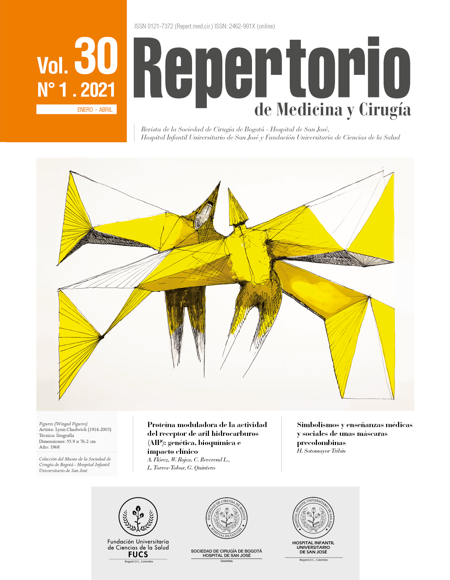Outcomes associated with normal saline solution vs lactated ringer´s solution in sepsis and septic or hypovelemic shock
Desenlaces asociados con solución salina normal versus lactato de ringer en sepsis y choque séptico o hipovolémico
![]()
![]()

Show authors biography
Objective: crystalloids are drugs used in critically ill patients, with ambiguous results when balanced solutions versus normal saline solution (NS) are used. The objective of this study is to determine if there are differences when NS (0.9%) vs. lactated Ringer´s (LR) solution are given to critically ill patients in sepsis or septic or hypovolemic shock, in terms of mortality, acute renal injury and length of hospital stay. Methods: a retrospective observational cohort study in patients over 18 years old with sepsis or septic or hypovolemic shock. Patients with chronic renal disease on dialysis, those hospitalized by gynecology/obstetrics and those diagnosed with brain death or organ donors were excluded. The primary mortality outcomes, acute renal injury and hospital stay were evaluated. Results: 314 patients were included, 158 in the NS group and 156 in the LR group. Acute renal injury occurred in 22.7% in the NS group and 25.8% in the LR group (OR 1.18 IC 95%:0.7- 2). Mortality rate was 49% in the NS group and 49% in the LR group (OR 1.01 95%: CI 0.63-1.63). Mortality risk factors included the use of vasopressor support (OR 35 95% CI 12-83) and acute renal injury (1.3 95% CI 1.01-1.69). Conclusions: no difference was found with the use of NS in critically ill patients with sepsis or septic or hypovolemic shock when compared with LR in terms of mortality, acute renal injury or hospital stay. The choice of which crystalloid to administer should be individualized, based on the comorbidities and the presence of hyperchloremia or hyperkalemia
Article visits 7462 | PDF visits 2927
Downloads
- Garnacho J, Fernández E, Ferrer R, Herrera ME, Lorente JA, Ruiz S, et al. Cristaloides y coloides en la reanimación del paciente crítico. Med Intensiva. 2015;39(5):303-315). DOI: https://doi.org/10.1016/j.medin.2014.12.007
- Chowdhury AH, Cox EF, Francis ST, Lobo DN. A randomized, controlled, double-blind crossover study on the effects of 2-L infusions of 0.9% saline and plasma-lyte® 148 on renal blood flow velocity and renal cortical tissue perfusion in healthy volunteers. Ann Surg. 2012;256(1):18-24. DOI: https://doi.org/10.1097/SLA.0b013e318256be72
- Morgan TJ. The ideal crystalloid - what is 'balanced'? Curr Opin Crit Care. 2013;19(4):299-307. DOI: https://doi.org/10.1097/MCC.0b013e3283632d46
- Prough DS, Bidani A. Hyperchloremic metabolic acidosis is a predictable consequence of intraoperative infusion of 0.9% saline. Anesthesiology. 1999;90(5):1247-9. DOI: https://doi.org/10.1097/00000542-199905000-00003
- Yunos NM, Bellomo R, Story D, Kellum J. Bench-to-bedside review: Chloride in critical illness. Crit Care. 2010;14(4):226. DOI: https://doi.org/10.1186/cc9052
- O'Malley CM, Frumento RJ, Hardy MA, Benvenisty AI, Brentjens TE, Mercer JS, et al. A randomized, double-blind comparison of lactated Ringer's solution and 0.9% NaCl during renal transplantation. Anesth Analg. 2005;100(5):1518-24, table of contents. DOI: https://doi.org/10.1213/01.ANE.0000150939.28904.81
- Khajavi MR, Etezadi F, Moharari RS, Imani F, Meysamie AP, Khashayar P, et al. Effects of normal saline vs. lactated ringer's during renal transplantation. Ren Fail. 2008;30(5):535-9. DOI: https://doi.org/10.1080/08860220802064770
- Yunos NM, Bellomo R, Hegarty C, Story D, Ho L, Bailey M. Association between a chloride-liberal vs chloride-restrictive intravenous fluid administration strategy and kidney injury in critically ill adults. JAMA. 2012;308(15):1566-72. DOI: https://doi.org/10.1001/jama.2012.13356
- Young P, Bailey M, Beasley R, Henderson S, Mackle D, McArthur C, et al. Effect of a Buffered Crystalloid Solution vs Saline on Acute Kidney Injury Among Patients in the Intensive Care Unit: The SPLIT Randomized Clinical Trial. JAMA. 2015;314(16):1701-10. DOI: https://doi.org/10.1001/jama.2015.12334
- Semler MW, Self WH, Wanderer JP, Ehrenfeld JM, Wang L, Byrne DW, et al. Balanced Crystalloids versus Saline in Critically Ill Adults. N Engl J Med. 2018;378(9):829-39. DOI: https://doi.org/10.1056/NEJMoa1711584
- Self WH, Semler MW, Wanderer JP, Wang L, Byrne DW, Collins SP, et al. Balanced Crystalloids versus Saline in Noncritically Ill Adults. N Engl J Med. 2018;378(9):819-28. DOI: https://doi.org/10.1056/NEJMoa1711586
- Rochwerg B, Alhazzani W, Sindi A, Heels-Ansdell D, Thabane L, Fox-Robichaud A, et al. Fluid resuscitation in sepsis: a systematic review and network meta-analysis. Ann Intern Med. 2014;161(5):347-55. DOI: https://doi.org/10.7326/M14-0178












